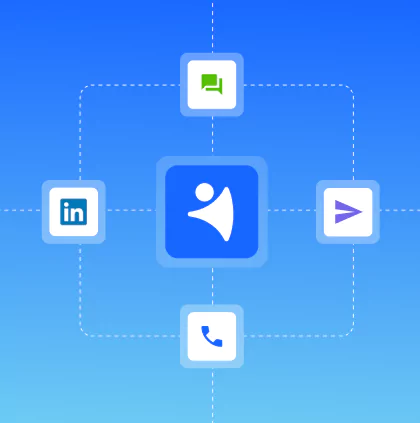Sales is about relationships. Learn how to create trust-first demos that make all the difference.
Nailed the discovery call? Time to seal the deal ?.
But here’s the catch: a generic, one-size-fits-all demo won’t cut it. Your prospect needs to see how your product fits their business, their goals, and their pain points.
They also want to know WHY they should trust you.
Here, strategy, preparation, and storytelling come in. Let’s break it down.
What is a sales demo?
Sales demo, short for sales demonstration, is a process of showcasing your company's product or service to a prospect. In most cases, sales and customer success teams are responsible for organizing and executing a demo session, during which they present the product’s features & advantages and how those can solve the prospect’s problem in the long run.
Commonly, a sales demo session lasts between 30 - 60 minutes (but sometimes can be longer) and aims to persuade the prospect that your solution is a perfect fit for their business and they should invest in it.
Preparation stage: Hope for the best, prepare for the worst
Just kidding ?. But honestly, don’t underestimate the value of good preparation.
If you’ve crushed it during the sales discovery call, you already have a good grasp on what your prospect is struggling with and the results they want to achieve strategically with your solution.
#1: Leave no stone unturned
We’re talking about real research here. Don’t just skim their website — look into their challenges, competitors, and growth areas.
- Dig deep into the company’s social media accounts, LinkedIn, website, and other open sources. Learning this information helps you tailor your pitch to what really matters to your prospect in a moment. For instance, a recent merger might indicate a shift in priorities or budget constraints. If that’s the case, then perhaps you should focus on cost-effectiveness and third-party integrations instead of pushing costlier plans.
- Research the key decision makers. Once you learn your audience, you know HOW to frame your pitch. Are you speaking to a CEO who cares about high-level business impact? A sales manager who needs efficiency and automation? An IT lead who prioritizes security and integrations? Either way, understand what drives each decision-maker on board and make a pitch that speaks value equally to each of them.
- What are the industry trends, challenges and opportunities? When you understand the bigger picture, you can align your product’s value with the industry’s pressing needs. For instance, if the industry is currently trending in AI, focus on the AI features of your solution. Or if the top industry challenge is customer churn, showcase how your solution improves retention.
- Who are the company’s competitors? Learn how to position your solution as the best alternative with the help of this data. If their main competitor is using a well-known CRM, point out how yours has better customer support, higher level of customization, or a lower total cost of ownership.

Alex Kasianenko
Account Executive, NetHunt CRM“The best demos start with deep understanding. Because when you truly understand what success looks like for the prospect, you can tailor the conversation to resonate and deliver real impact.”
#2: Keep your demo session structured, but leave room for adjustments
There is nothing worse than a meeting that is chaotic, hence, leads nowhere. A perfect demo is somewhere between 30-60 minutes with an approximate structure as follows:
- 10 minutes for quick chit-chat, intro, and recap;
- 30 minutes of actual product demonstration;
- 15 minutes of a questions-and-answers session;
- 5 minutes for the discussion of the steps to follow and goodbyes.
? If your demo covers multiple aspects, encourage leads to ask questions after each key point, slide, or feature presented instead of waiting until the end. This way, you’ll keep your prospects engaged through the entire session and reduce confusion.
?Tweak the structure depending on the customer’s behavior. Are they the type who’s been playing Twenty Questions from the beginning? Then you’ll definitely need more than 10 minutes for Q&A. Or, perhaps, they’ve already used a solution similar to yours and just need a quick walkthrough. In this case, 10-15 minutes might suffice for the Q&A part.
✅ Bonus tip: Send the agenda and any background materials in advance. This tells the recipient you genuinely care about their time and is a way to ensure good show rates, especially if that recipient is the key decision maker in a company.
#3: Get ready for objections
It’s pretty impossible to deliver a solution that EVERYONE in a company falls in love with from the moment they see it. You’d get objections like “Too complex,” “Too expensive” or even “Why fix what isn’t broken?” and more… ?
How to deal with objections? Let’s cut to the chase.
- Focus on customer benefits. We know you might love boasting about stats and numbers, but keep it relevant. They might say, “Automation is overrated”. Then, you bring value by saying, "With our automation, your team can save up to 10 hours per week on manual data entry."
- Add real-life cases. Share how similar companies faced the same challenges and how you helped them overcome those obstacles. You can proceed with “One of our clients (you can name the client if the latter allows) had the same concern about switching CRMs. After implementation, they saw a 30% boost in pipeline efficiency within two months.”
- Focus on how your tool aligns with the company’s broader strategy. This is especially important if leadership is on the call. You might get an objection like “Why change things if they already work?” You might answer, “Sure, your current system works, but can it scale? You don’t want to invest in another costly solution in a few years when your team expands.”
Now let’s move to how you can build trust during the actual product or service presentation.
Execution: Make the demo about THEIR challenges
A quick suggestion before we proceed: personalize the demo from the very beginning.
Start with a friendly chat to break the ice. Simple questions like “How’s your team doing?” or “What’s been the highlight of your week?” help build rapport. You can also weave in the company’s news and ‘attach’ it to the problem they’re going through, the one your solution can help with, something like ““Congrats on your team’s expansion! That must make [specific challenge] even more pressing.”
In other words, keep showing your product’s value.
Focus on the risky outcomes
Here is the deal: a human mind focuses and processes negative data more actively than positive, a survival instinct our ancestors developed to spot danger. Sure, there are no tigers or crocodiles in the meeting room, but this evolutionary instinct still influences our decision-making.
So, show the good and the bad: the one path where they adopt your solution and reap benefits and the second one — a gloomy place filled with risks, challenges, lost revenue, and unhappy customers.
Let’s say you’re offering a digital solution that automates sales activities. You can use the language of numbers and tell the prospect the rate at which their sales will be dropping if they don’t add automation to their workflows. At the same time, tell them the rate at which successful businesses are growing with automation, creating a strong contrast that highlights the urgency.

Alex Kasianenko
Account Executive, NetHunt CRM“Your job isn’t just to demo a product — it’s to connect the dots between their challenges and your solution. Frame every feature around the value it brings to them. When prospects see how your tool fits into their workflow and helps them win, you’re no longer selling — you’re solving.”
Visualize!
Our brains process visuals way faster than text and make those abstract things really stick to your mind.
So, here are few ideas:
- Present statistics with infographics;
- Use comparison charts to show the impact of your solution (like the ‘before’ and ‘after’ effect);
- Add short videos for dynamic explanations (everything depends on the type of product or service you sell. For instance, if you’re in real estate, then your clients would definitely benefit from interactive property walkthroughs);
- Show step-by-step workflows with screen recordings (again, depends on your product and service);
- Spice it up with memes and GIFs to evoke emotional response. We all love laughing, right?
✅ Bonus tip: Always read your audience. If they’re more data-driven, focus on charts and graphs. If they’re creative, bring in some compelling visuals or product demos.
Turn boring data into eye-opening narrative
Let’s face it, stats about when you launched a product or how many people you’ve helped can make your customer’s eyes glaze over. So, weave these numbers into a story that resonates with them.
Here is how to make your storytelling engaging:
- Show them how your product made a real difference. A success story that shows how you helped someone just like them can leave a lasting impression.
- Frame statistics in a relatable way, such as “Clients save 10 hours per week. Imagine how many tasks you can finish with that extra time!”
- Compare “before” and “after” scenarios to illustrate transformation.
- Add testimonials that highlight specific improvements.
- Use metaphors and comparison to simplify complex data and ideas and make them more digestible.
✅ Bonus tip: Keep your terms simple. No need for tech jargon, as complex terms would only confuse your customer and make them think that your solution is overly complicated.
Add open-ended questions and encourage honest feedback
A sales discovery call is when you’re actively listening and trying to understand the prospect’s problem, while a sales demo is when you switch places with the customer and GUIDE. Don’t just ask, “Do you think this feature helps?” Instead, present solutions and handle objections proactively.
And the more they challenge your ideas, the better. It shows they’re engaged, and you can use those objections to further reinforce your product’s value.
Plus, it often happens that during a demo session, your customer will suddenly remember a feature they’ve been craving for a while. This is your chance to show them how your product already delivers that feature or offer a future roadmap if the feature is still under development.
⚠️ Never lie about your product’s costs or pretend to know answers you don’t. One way or another, a lead will discover the truth. If there are add-ons or fees, disclose them early to build trust. And if you don’t know the answer to a question, say: “Great question! I’ll check with our team and get back to you today.”

Alex Kasianenko
Account Executive, NetHunt CRM“Transparency builds credibility. Be clear about your product’s strengths, limitations, and pricing from the outset — no surprises, no fluff. When leads see you’re honest, even when it’s not convenient, it sets a foundation of trust that drives long-term relationships.”
Finish: Move to the next logical step without being pushy
We understand: sometimes it’s easier said than done. Nonetheless, it’s important, as a strong finish in a demo keeps the momentum going and ensures the prospect knows what to do next.
Here are a few things to do in order to close strong.
- Summarize the key benefits you’ve discussed during the demo.
- Offer a clear next step: a free trial or a post-demo follow-up.
- Your prospect might be ready for the proposal stage, but it would be better if they vocalize the idea themselves.
- Confirm their decision-making process and timeline.
- Suggest the exact time for following up and offer a short add-on meeting if questions arise during their decision-making process.
⏳ A perfect follow-up window is 24-48 hours after the demo while interest is high.
Final thoughts
When done right, your demo won’t just be memorable — it’ll be the reason they say yes.
A great sales demo is all about delivering a personalized, engaging, and value-driven experience. It’s about showing a prospect that you truly care and want to help.
So, keep your audience’s pain points at the center, balance storytelling with data, and guide them toward the next steps naturally. When you align your demo with their specific challenges and goals, you transform it from a simple presentation into a compelling business case.
You’ve got it!
FAQ
What is a sales demo vs. a product demo?
A sales demo presents the product’s or service’s value in how it can solve customer’s specific pain points. A sales demo is highly personalized and focuses on real-world applications. A product demo, on the other hand, is a more general walkthrough of the product’s features and use cases.
How to build trust during a sales demo?
Trust is the foundation of a successful demo. Here are some ways to build it:
- Be transparent about pricing and limitations.
- Use real-life examples and case studies.
- Address concerns honestly — don’t oversell or mislead.
- Tailor the experience to their business needs.
How to make a good demo?
A great demo is engaging, interactive, and focused on the customer’s needs. Here’s how to make it effective:
- Keep it interactive — encourage questions and discussions.
- Focus on their pain points, not just your product’s features.
- Use storytelling to make your product relatable.
- Close with a clear call to action (trial, next meeting, etc.).




















 product experts — let's find the best setup for your team
product experts — let's find the best setup for your team